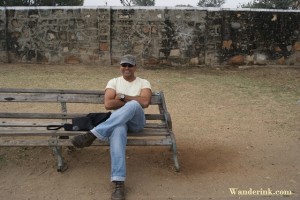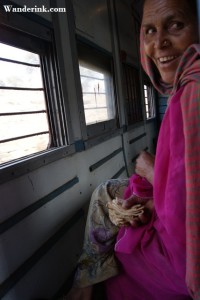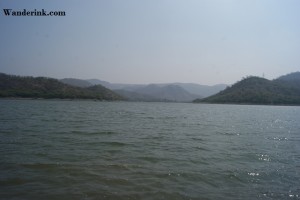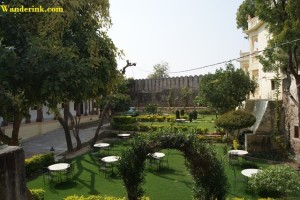Angrezi babuls scramble from both sides eager for a prickly embrace, turns around with a ‘whoa’ just as you pass. We sped along a spit of a tarmac flanked by bristly rows of the shrub towards Khamblighat railway station; the train had to be late by at least 10 – 15 minutes if we were to get on it. But my host Thakur who was driving didn’t seem to be worried.
“These were brought from Africa.” Thakur said with a vague nod.
For a moment I thought he was talking about the metre gauge train we were portended to miss. Probably he was telling me – in a way – not to worry about it being on time.
“Maharaja Umed Singh of Jodhpur brought the babul from Africa and sowed the seeds from a helicopter.” He said eyes narrowing as the jeep gathered speed with all the clangour and comfort of a Patton tank. The idea was to have a green cover over an otherwise arid brown region. But the progressive maharaja’s idea came a cropper – the leaves turned out to be poisonous making it inedible for livestock and the plant quaffed scarce ground water mortifying the desert folk. Too late to do anything as it had by then spawned vast and wide like Genghis Khan and his virile marauders. The resilient and resourceful inhabitants realising the futility of trying to weed out the omnipotent took recourse to their own ingenuity.
“The babul is used widely today by many villagers as boundary walls and it’s especially effective in preventing cattle from straying out.” Thakur finished as we reached Khamblighat station. We were informed by the waiting locals with many deferential bowing of heads – the ‘Thakurs’ are a line of erstwhile rulers and are still holders of huge tracts of land – that the train was running late. As I let out an audible sigh of relief Thakur’s forehead became a cataract of frowns and then his eyes shone.
“The babul has thick stems which are used for firewood and it’s really an inexhaustible source of coal.” He said with the sudden gush of fondness seen in a father who just remembered the prodigy in the prodigal.
Though it was Thakur who drove the 30 kilometres from Auwa, a quaint, historic village in remote Rajasthan where I was staying, to Khamblighat railway station one of the drivers employed by the Thakurs rode with us as the jeep had to be taken further ahead to Phulad junction 22 kilometres away where we would disembark. And head back to Auwa via Phulad Dam. We got our tickets from an invisible, garrulous man behind a window and waited on the platform.
Fulvous sunlight bounced off the tracks announcing the summer round the corner. A derelict tin shanty braved the simoom gusts that swirled with alacrity. The latch on the lean-to-itself – barely clamped in place by a wobbly screw – was secured with a new stainless steel lock which shimmered like the epaulette on a discarded uniform. Derelict train bogies stood restive in the junkyard not yet in terms with the end of chugging days. A circular iron mounting – an old fashioned bell – was fastened to a pole, hooked through a severe looking loop at one end and welded at the bottom. Locals waited with the indulgent impatience accorded by school children to the crippled ice cream vendor who hasn’t turned up yet at lunch hour. In the midst of all this humdrum an ornate stone lavabo stood in elegant, ancient isolation. Designed along a sprightly overlapping bloom, its moline petal edges had crumbled away to time. A rusted metal pipe loomed next to it, a lone sentry, grappling with lost regalia and relevance.
The train journey from Khamblighat to Phulad is an eye-opener of sorts – unveiling a never-before Rajasthan, a green Rajasthan. During the ride that takes over an hour, you get to see a wholly new face of the ‘desert state’ – one that is accosted by the verdant Aravali range and quite removed from the dunes and dromedaries. The 22-km ‘train safari’, as it is known in touristy parlance, takes over a smoke-belching, grunting hour and passes through numerous palm oases and wadis, stone pools and burrowed escarpments which are winter residences for nomadic tribes. The track runs across grassy jebels and vertiginous valleys, the lap over the Kamla Nala is particularly picturesque. After about half an hour into the ride, lookout for the Phulad Dam which dapples under the midday sun like the stones on a hastily doffed necklace.
Conceived nearly a century ago by the maharajas of Jodhpur and Udaipur to connect their kingdoms, the train still runs on metre gauge. The engine which ran on steam was only recently converted to diesel. Repeated attempts by authorities to convert the line to a regular broad gauge with modern engines and added compartments met with stiff resistance not just from the heritage property owners in the region but from the locals too. For families, schools and dating couples picnics begin with the ride itself. The bonhomie is infectious. There are three or four tunnels en route which waft dark; shrieks and wolf calls bounce off the crenellated silhouettes bidding you into the high decibel fray. The train gets almost emptied out at the Goramghat station, one stop before Phulad: From here 1,000 steps lead to the Goramnath Temple, a popular picnic/pilgrim destination.
A particularly amiable lady who was sitting by herself offered me some rotis she held in her hands. Delighted I was just about to take a bite from it when she lunged and plucked it away from me choking in her own chortle. I saw an approaching tunnel through the open door and getting a bit wary at what had just transpired decided to scoot from the otherwise deserted compartment. From her animated gestures I gathered that she wanted me to stay; I was in a quandary and Thakur was nowhere around to confer with. Just as we were about to enter the tunnel the train groaned to a stop and bands of monkeys descended from the surrounding rocky ramparts. The simians moved with a casual confidence along the tracks, not once looking up at the train. Almost everyone on board gave them something – from freshly bought bananas and biscuits to mostly stale rotis from yesterday, like my chuckle-happy lady. When it dawned on me as to why she gave me the rotis I asked her for some. This time she gestured to me to gobble them down. We hit it off.
Soon enough Thakur came to me running – he had been looking for me all over. He was panting and looked rattled; I presumed it was because I had struck up with the laughing lady, quite apparently a commoner. We were jostling each other at the door and tearing off rotis from each other’s hands. The monkeys were also watching first startled then bored.
“I wish I had my gun.” Thakur announced.
I was sure that I had smirched his social standing with my usually misunderstood congeniality. Then could it be so bad this day and age? But I was in hinterland Rajasthan which was a lot different from the rest of the country. For example here opium was every day. But hey, that’s another post. It turned out that that Thakur spotted one gorgon of a wild boar not very far from where we had stopped. The vision of a skewered loin dripping white fat that sizzled like comets into the fire gripped me agape like a groupie before the swoon diagnosed these days as Bieber fever.
“I wish you had your gun.” I heard myself say.
We undertook some distress eating at Phulad junction with copious quantities of piping hot mirchi baji and mawa, a sweet made from milk, all washed down with ‘cheeni-kum’ chai. The driver was waiting with the jeep and we headed to Phulad Dam. A non-stop breeze had shingled the expansive emerald green surface of the water. Some tribal youngsters who had set up temporary settlement along the catchment were angling in their caiques. The floodgate was closed and there was a water snake lashing about as if in protest. Across the bund the soil was still brittle and fricative but flower gardens and lush fields went on like an extended oasis.
It took some raucous Rawat farmers in their colour coordinated headgear, mattocks slung over shoulders who passed by trailing beedi smoke to remind me that I was indeed in Rajasthan.
Best from: Fort Auwa in Auwa village, a newly-opened heritage hotel, with 18 unique rooms each done up differently with locally procured handicraft items and paintings. All the rooms have comfortable double-beds, faultless white linen, study tables, man-size wardrobes, full length mirrors and en suite bathrooms. Exclusion of television is a thoughtful oversight as well as intercoms – which means you have to discuss your culinary preferences in advance. The Thakurs of Auwa – who own Fort Auwa – trace their lineage to Kushal Singh who lent his troops to support the mutineering sepoys of the 1857 revolution. The village itself is steeped in history and tradition, warm people and respectful bows.



















